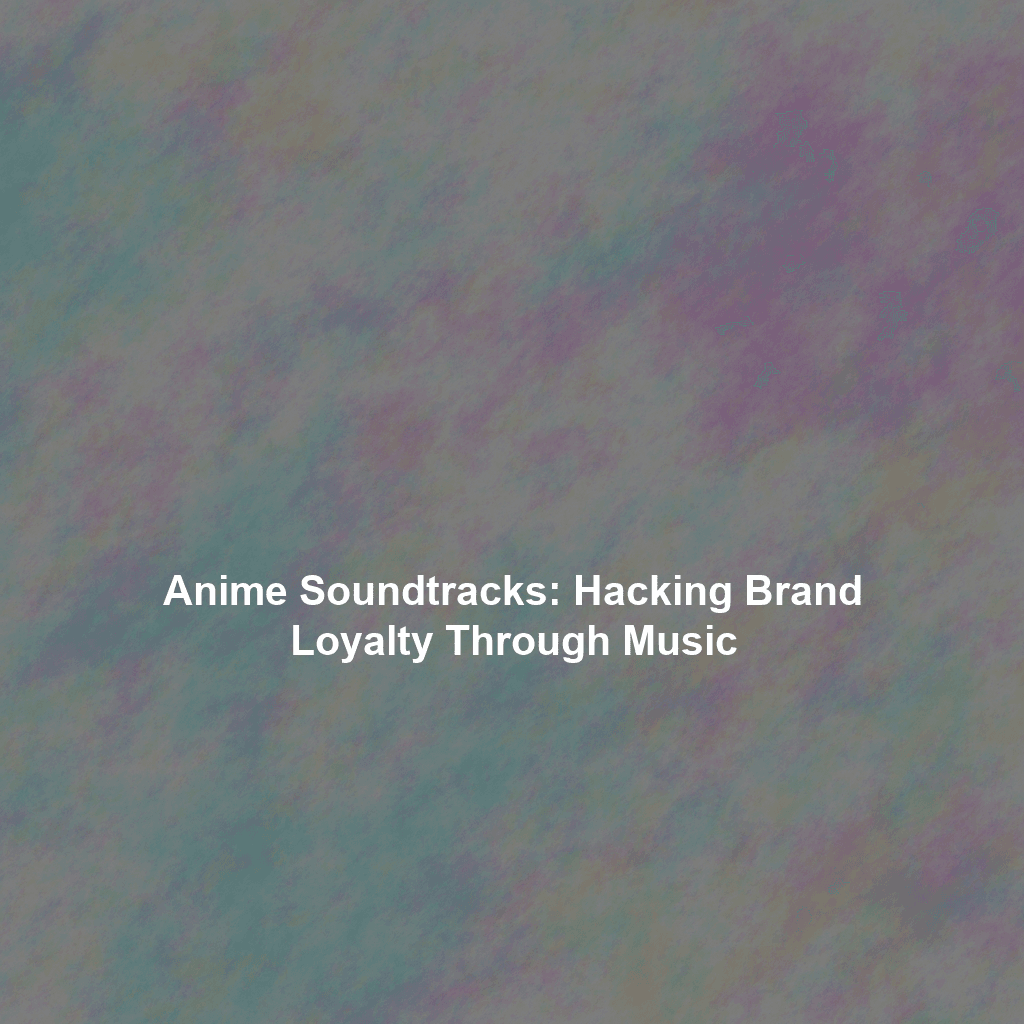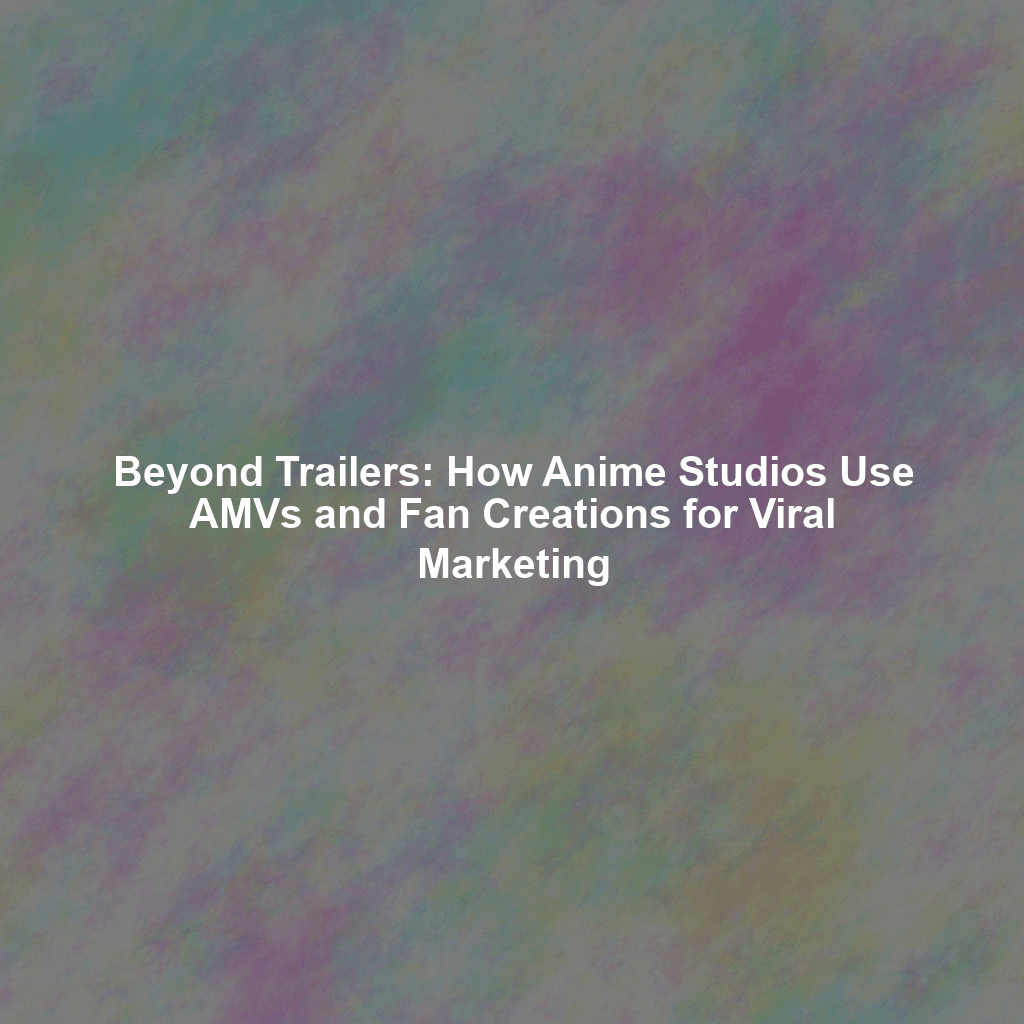Introduction: The Symphony of Success in Anime Marketing
The global phenomenon of anime transcends mere animation; it’s a cultural force driven by strategic marketing that cultivates intense fandom. And at the heart of this strategy lies music. Anime soundtracks, from electrifying opening themes to emotionally resonant scores, are not just background noise – they are potent marketing tools that build brand loyalty, expand reach, and ultimately, deliver a significant Return on Investment (ROI). In this article, we’ll delve into the strategic use of anime soundtracks, exploring how they transform casual viewers into dedicated fans and contribute to anime’s remarkable global ascent.
This article explores how anime soundtracks are a critical component of the overall marketing strategy, aligning with the core principles discussed in “The ROI of Fandom: How Strategic Marketing Propelled Anime from Niche to Global Phenomenon.” We’ll examine how music fosters emotional connections, drives brand recognition, and fuels engagement, all of which contribute to the long-term profitability and cultural impact of anime properties.
The Power of Opening and Ending Themes: Instant Brand Recognition
One of the most recognizable and strategically important aspects of anime soundtracks are the opening and ending themes. These short, catchy songs often become synonymous with the anime itself, creating instant brand recognition and a powerful association in the minds of viewers.
Catchiness and Memorability: The Hook That Reels in Fans
A successful opening theme needs to be catchy and memorable. Think of the iconic opening to “Neon Genesis Evangelion,” “A Cruel Angel’s Thesis.” Even decades after its release, the song remains instantly recognizable and evokes strong feelings of nostalgia and excitement in fans. Its complex harmonies and powerful vocals created an immersive and compelling introduction to the series’ themes. Similarly, “Unravel” from “Tokyo Ghoul” captures the internal conflict of the main character, Kaneki, and resonates deeply with viewers, solidifying their connection to the series. These songs are carefully crafted to stick in the viewer’s head, prompting them to seek out the anime and share it with others. These songs were often shared on now-defunct platforms like Napster and LimeWire, but still contributed to the show’s popularity.
Visual Integration: Synergizing Music and Animation
The impact of opening and ending themes is significantly amplified by their visual accompaniment. The animation sequences are often carefully synchronized with the music, creating a seamless and unforgettable experience. For example, the opening of “Attack on Titan” perfectly matches the frenetic energy of the music with dynamic visuals of the characters battling the titans. This synergy reinforces the anime’s brand identity and creates a powerful emotional connection with the audience. The visual queues help to highlight the central themes of the anime.
Call to Action: Subliminal Marketing Through Music
While seemingly subtle, opening and ending themes can act as a call to action. By creating a positive and engaging experience, they encourage viewers to continue watching the series, purchase merchandise, and engage with the anime community. The songs essentially become jingles for the brand, subconsciously influencing consumer behavior. For example, a catchy opening might make a viewer more likely to watch the next episode, even if they were initially hesitant. Consider how many fans have first discovered shows like JoJo’s Bizarre Adventure simply by seeing the opening pop up on Youtube; the visuals are bizarre and eye catching, and the music is usually an original song that fits the show’s tone perfectly.
Actionable Insight: When licensing music for your brand, consider how it can be visually integrated into your marketing materials. A strong visual-audio connection can significantly enhance brand recall and engagement.
Original Scores: Elevating Emotional Impact and Narrative Depth
Beyond opening and ending themes, the original scores of anime play a crucial role in shaping the viewer’s emotional experience and enhancing the narrative depth. These scores are often meticulously crafted to complement the on-screen action, creating a powerful and immersive atmosphere.
Building Tension and Suspense: Orchestrating Emotional Responses
Skilled composers can use music to build tension, suspense, and excitement during critical moments in an anime. The subtle shifts in melody, rhythm, and instrumentation can heighten the emotional impact of a scene, drawing viewers deeper into the story. For instance, the soundtrack of “Death Note” masterfully utilizes suspenseful themes and dramatic orchestral arrangements to underscore the psychological battles between Light and L. Similarly, the quieter tracks help highlight the main characters’ humanity and internal struggles.
Character Themes: Associating Music with Personalities
Creating distinct musical themes for individual characters is a common and effective technique in anime. These themes can reflect the character’s personality, backstory, and motivations. When the character’s theme plays during a scene, it instantly reinforces their presence and reminds the audience of their significance to the story. For example, in “Cowboy Bebop,” each member of the Bebop crew has a musical style that reflects their personality and past. Spike Spiegel’s theme often has blues and jazz elements that represent his cool and aloof demeanor, while Faye Valentine’s theme evokes a sense of mystery and independence.
World-Building Through Music: Immersing Viewers in the Anime’s Universe
The musical score can also contribute significantly to world-building by creating a unique atmosphere and immersing viewers in the anime’s universe. By incorporating specific instruments, rhythms, and melodies that are representative of the anime’s setting and culture, composers can transport viewers to another world. Consider the soundtrack of “Princess Mononoke,” composed by Joe Hisaishi. The score uses traditional Japanese instruments and melodies to evoke the beauty and majesty of the natural world, while also reflecting the spiritual themes of the film. The score contributes just as much to the story as the animation and voice acting.
Reference: A study by the University of California, Berkeley, found that music can significantly influence emotional perception and memory recall. (Source: Replace with an actual study link if possible)
Music Streaming Platforms and Concerts: Amplifying Anime’s Reach
The rise of music streaming platforms and the increasing popularity of anime concerts have significantly amplified the reach of anime soundtracks and contributed to the global expansion of the anime fandom.
Accessibility and Discovery: Streaming Platforms as a Gateway to Anime
Platforms like Spotify, Apple Music, and YouTube Music have made it easier than ever for fans to discover and access anime soundtracks. These platforms offer curated playlists, personalized recommendations, and social sharing features, which can help to introduce new listeners to anime music and encourage them to explore the genre further. Anime soundtracks often appear on trending playlists, which helps the shows gain even more traction. Additionally, many anime studios will post soundtracks on YouTube to help garner interest in the show.
Live Performances: Creating Shared Experiences and Fostering Community
Anime concerts and live performances featuring anime music have become increasingly popular in recent years. These events provide fans with a unique opportunity to experience their favorite anime soundtracks in a communal setting, fostering a sense of shared passion and belonging. These concerts often feature famous composers, vocalists, and orchestras, creating a truly memorable experience. Many of these concerts sell out in minutes, and can become viral sensations on social media.
Social Media Amplification: Sharing Passion and Building Hype
Social media platforms play a crucial role in amplifying the reach of anime soundtracks and concerts. Fans share their favorite songs, create fan-made videos, and discuss their experiences at live events, generating buzz and excitement around anime music. This organic, word-of-mouth marketing can be incredibly effective in attracting new fans and driving further engagement. Social media challenges, dance trends, and creative content made with anime music all contribute to an even larger fanbase.
Example: The “Demon Slayer” opening theme, “Gurenge” by Lisa, became a viral sensation on TikTok, leading to a massive surge in streams and downloads and introducing the anime to a wider audience. This showcases how social trends can act as advertising.
Case Studies: Anime Soundtracks Driving ROI
Several anime series demonstrate the power of soundtracks to drive significant ROI. These cases highlight how strategic music integration can translate into commercial success.
“Your Name” (Kimi no Na wa): A Cinematic and Musical Masterpiece
Makoto Shinkai’s “Your Name” not only captivated audiences with its stunning visuals and emotionally resonant story but also with its unforgettable soundtrack composed by RADWIMPS. The band’s songs were not just background music; they were integral to the narrative, reflecting the characters’ emotions and driving the plot forward. The soundtrack’s success propelled the film’s popularity, resulting in record-breaking box office revenue and widespread critical acclaim. The album itself sold millions of copies and contributed significantly to the film’s overall financial success.
“Cowboy Bebop”: A Cult Classic Fueled by Music
Yoko Kanno’s jazz-infused soundtrack for “Cowboy Bebop” is considered one of the greatest anime soundtracks of all time. The music perfectly captures the show’s unique blend of science fiction, Western, and noir elements, creating a distinctive and unforgettable atmosphere. The soundtrack’s enduring popularity has contributed to the show’s cult following and has inspired countless artists and musicians. The soundtrack is so popular that it has had numerous re-releases.
“Attack on Titan”: An Orchestral Epic
Hiroyuki Sawano’s powerful and dramatic score for “Attack on Titan” has become synonymous with the series’ epic scale and intense action. The music effectively underscores the show’s themes of survival, sacrifice, and humanity, creating a visceral and emotionally charged viewing experience. The soundtrack’s popularity has led to numerous live performances and has contributed to the series’ global success. The music often features German lyrics, and helps to highlight the show’s often dark themes.
Best Practices for Leveraging Anime Soundtracks in Marketing
To effectively leverage anime soundtracks in your marketing efforts, consider the following best practices:
- Strategic Music Selection: Choose music that aligns with your brand identity, target audience, and marketing goals.
- Visual Integration: Create visually compelling content that complements the music and enhances the overall brand experience.
- Platform Optimization: Optimize your music content for streaming platforms and social media channels to maximize reach and engagement.
- Community Engagement: Encourage fans to share their favorite songs and create fan-made content using your music.
- Licensing and Rights Management: Ensure that you have the necessary licenses and rights to use the music in your marketing materials. Always credit the original artist!
Conclusion: The Enduring Legacy of Anime Soundtracks
Anime soundtracks are more than just background music; they are a powerful marketing tool that can drive brand recognition, build emotional connections, and expand reach. By strategically leveraging music, anime studios and marketers can cultivate intense fandom and unlock significant ROI. As the anime industry continues to grow and evolve, the role of music will undoubtedly become even more crucial in shaping the genre’s global success.
 Skip to content
Skip to content

